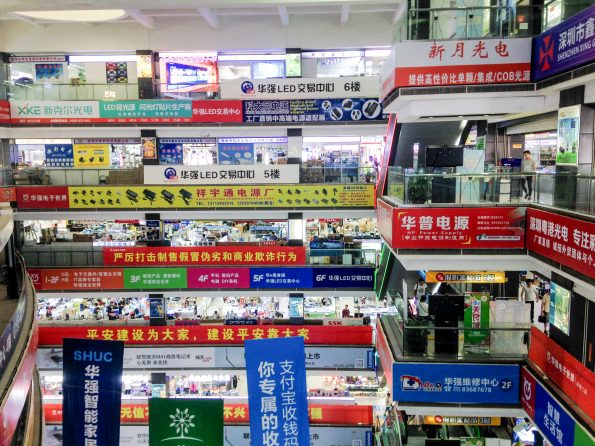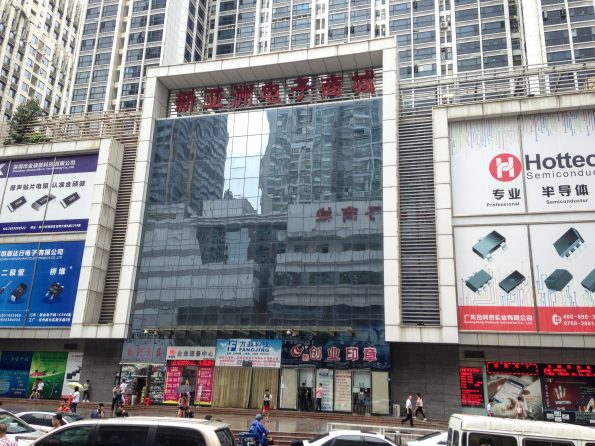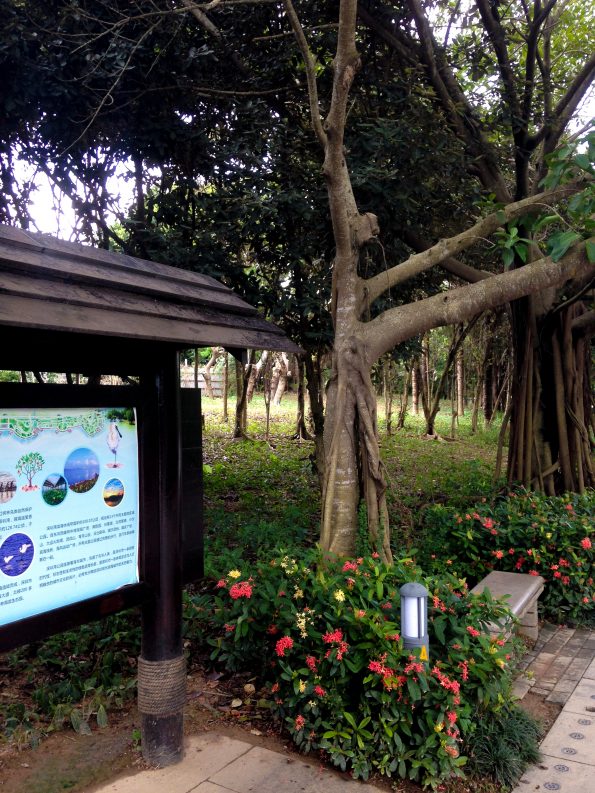The New Capital of Tech – Shenzhen, China
Shenzhen is the largest and most important city you’ve probably never heard of…yet. Unless you are in the Tech Start Up game or work with hardware, you may be unaware of Shenzhen, its role in the global economy and the young talent flocking across the world to work there. As for travelers, Shenzhen may be the first city you visit on the mainland as it’s just outside of Hong Kong and on the way to Guilin, another popular tourist destination.
After a few days in Hong Kong, I spent a full day exploring Shenzhen with a local friend before making my way to Guanzhou, the modern name for the ancient port city of Canton. Guangzhou and Shenzhen are two cities of a much larger area called the “Pearl River Delta” which is the single largest manufacturing region in the world. Shenzhen is essentially a new city where none existed not long ago. So it’s your greatest chance to see just how modern China has become! From the best Tech Shopping Malls, to beautiful skyscrapers and public parks, It’s a truly impressive city.
- Quick Intro to Shenzhen
- Gizmos and Gadget Shopping
- Start Up Central
- Photo Gallery
- Mangrove Nature Reserve
Welcome to Shenzhen, Guangdong
In 1979 Shenzhen was a small fishing village between Guangzhou and Hong Kong with a population of 30,000 people. Small, insignificant and not very noteworthy to the outside world. However, in order to compete with Hong Kong which had been booming economically as the financial center of Asia, the Chinese government created the first “Special Economic Zone” (SEZ). These zones didn’t require oversight from the government to conduct business, so less regulation, more special tax incentives and essentially a free-market economy inside of a socialist country. It was still the 1970s after-all.
- 1980 Shenzhen Photo by Leroy W. Demery
Check out this article on before and after images of Guangzhou, Shenzhen, Macau and Hong Kong. For Shenzhen. It’s a truly remarkably transformation, and not without some pretty unjust acts by government officials. It happens all over the world, the same story of business insiders or politicians trying to buy up real-estate along new highways and train routes before the general public realizes it. Sometimes they offer great deals to locals, or simply force people to give up their land and homes for next to nothing, knowing that the value of this land will soar considerably in the near future. In Canada, the government stole both the land and resources from natives, and even their children in some areas. Shenzhen wasn’t any different.
Fast forward to 2010 and Shenzhen is the world’s hardware capital, supplying Silicon Valley with 30% of its computer and electronic parts. This is the city where Tencent, Huawei and ZTE are headquartered. You may have seen commercials for Huawei phones or saw a ”Tencent” folder in your phone’s data storage. Now, ZTE is in the news in America as the focal point of a trade-war with China.
- Shenzhen 2011
The city has over 10 million people. Except only 1/4 are actual residents while the remaining workers don’t have the required living permits. They are migrant workers and don’t have access to any local services, can’t buy real-estate and may have a hard time staying employed. In China, this is known as the Hukou system. It’s a form of population control, a way to keep people from migrating to the same places. Otherwise Beijing would have 100 million residents instead of 20 million. For Shenzhen, the booming economy has created opportunities for young workers. For many of them, it’ll be worth sticking around even though they may never be permanent residents.
Gizmos and Gadget Shopping
The most interesting activity for travelers to Shenzhen is walking through the maze of tech market stalls in the major shopping centers. With so many start-ups and the world’s best supply of hardware, you can expect to find a wide range of crazy products. Unfortunately, 99% of the things you find are useless. Hilariously, Utterly, Useless. It’s like a mission to find a needle in a hay stack… to find that next big thing.
It’s called the Huaqiangbei Electronics Market in Futian District of Shenzhen. Other bloggers will rave about the awesomeness that happens here, maybe geek out a little at all the new tech. Have at it, it’s just not my thing. After a good 30 minutes of wandering the stalls I had seen enough. I suspect this to be the case for the majority of travelers.
For most younger westerners, we have moved away from collecting ‘stuff’ to collecting ‘experiences’. That’s part of why I travel, to experience the world. I’m not sitting at home watching QVC or the home shopping network… I’m in China! Still, it’s worth checking out this market because you might find a gem hidden in all that junk, something new and exciting to show off to your friends back home.
I saw over 1,000 fidget spinners, a hundred stalls piled high with smartphone cases, random wires & LED lights. The more established product stalls had things like 1080 HD Knock-Off Gopros Cameras for $50 USD, helmet lights and drones. So many drones! You can also find dozens of selfie sticks, selfie fans, USB LED lights and USB cables. Find out what you can buy with $50 USD here.The knock-off are called Shanzhai meaning ‘Mountain Village’ where you can’t be caught! Copying technology is part of the innovation culture in Shenzhen, like the wild west of tech but in the east!
This documentary on the tech in Shenzhen showcases some of the funny things invented here. Perhaps just for the sake of inventing something, who knows. Like floating alarm clocks for the pool or fish tank. Remember those 1950s exercise belts that vibrate to help women lose weight without having to do any exercise?
Well you can find the 21st century version in Shenzhen! Along with fake IPhones, VR Glasses and dozens of tech incubators for aspiring entrepreneurs. You can expect to see a tremendous amount of innovation to come out of Shenzhen in the near future, and it’ll be impossible to tell the real from the fakes.
Start-up Central, A New Focus on Innovation
Tech innovation in China has seen some challenges. For decades Chinese manufacturers have famously been able to create fake copies of products without penalties or legal consequences. Everyone has seen pictures online of ‘Rorex’ ‘Prado’ and ‘Gacci’, famous brands turned into cheap novelty products for tourists. Chinese manufacturers have always copied technology from other countries and were rarely the original innovators. The most famous invention to come from China is probably paper back in 100 BC. The only products they seemed unable to copy were encrypted software like iOS systems, but now that’s not even a guarantee. However, when it comes to hardware, manufacturers would pick up new products, reverse engineer them in days and release cheaper, knock-offs within a week with new branding.
But times have changed and the central government has begun to crackdown on retail platforms like TaoTao and Alibaba who make it possible to buy these fake products. Now that China has emerged as a center of innovation, they are striving to protect their intellectual property in order to encourage more sustainable innovation. Without patents and copyright protection, companies had little incentive to do research & development. Why would you? When you could just copy someone else’s invention without incurring any of the expenses. In the long-run this is a tremendous limitation to the local industry. For a city that is supposed to be 1 year ahead of everywhere else technologically, they may find it difficult to find the long-term investors and reliable growth required to keep booming. All the hardware may be built in China, but the software is always made in the USA, Germany or other countries with better legal enforcement of intellectual property rights.
The problem is that Silicon Valley is too slow and expensive compared to Shenzhen. Why hire 20 programmers at $150,000/ year salaries when you could hire hundreds of workers for the same price? Shenzhen’s leading companies are turning out both software and hardware products faster than anything in America’s tech capital. Tencent’s market cap is over 500 Billion USD while Apple Inc is closing in on 1 Trillion USD. However, Tencent outspends Apple in R&D and has enjoyed exclusive access to the World’s second largest market, whereas Apple must compete with global competitors in the United States. The same comparison can be made between Jeff Bezos’s Amazon and Jack Ma’s Alibaba Group.
The start-up scene in Shenzhen is simply on fire. Now they also have global multi-national competitors breaking into the global markets. I recommend a read of this Economist Article, or check out the Tech Talk Podcast on our China Books & Things Page. Trust me, this is only the beginning for Tech in Shenzhen.
Photo Gallery
Shenzhen Mangrove Nature Reserve
What some call a mini protected area is China’s smallest nature reserve. The small park is filled with beautiful mangrove trees, bamboo forests and over 100,000 birds in only 368 hectares of land along the coast of Shenzhen in the Futian District. The park was established in 1984, long before the mass urban development of the region as we’ve seen. But only two years after being created, the park hosted it’s most famous guest: Prince Philip, the Duke of Edinburgh… You know… the husband to the Queen of England, Elizabeth II. The park is a well-known resting place for 179 species of coastal and migrating birds and at the time the Prince was the President of the World Wildlife Foundation and an avid birder. He even published a book in 1962 called “Birds of Britannia”. Full-disclose, the Prince was also fond of shooting birds.
The park was also called the “Green Pearl” of Shenzhen, it certainly feels that way! Walk along the wide board-walk that stretches along the coast and you’ll see an endless horizon of skyscrapers jutting out on both the left and the right side! Turn around and you’ll see even more soaring up towards the rest of mainland China. In the middle of all this urban chaos is this little slice of tranquility, perfect for a morning stroll! Finding the park can be a little challenging as there is a major highway that is difficult to cross. Have patience and walk along the street until you find a tunnel that’ll bring you to the other side.
The last thing I’ll touch on is what I have come to call ‘the two sides of China’. What China was yesterday, and what It’s becoming tomorrow. I mentioned the innovation of technology but the changes extends much further and there is no better example than garbage. While rural China has garbage and plastics scattered around the countryside, urban China has been revolutionizing garbage and recycling. These massive super cities like Shenzhen create a tremendous amount of waste. Take 10 million people in Shenzhen compared to 5 million in Sydney, Australia. It’s twice as big! But now add another 110 million people in the rest of Guangdong Province, Hong Kong and Macau. Where do you put all that waste?
The Shenzhen government has began to fine residents and businesses for not sorting waste from recycling. Keeping the city clean and garbage free is very important for attracting business and investment. Where residents in Canada can just find an open field and bury the waste, this would be impossible in a country of 1.3 billion people. In Australia, the government is in crisis mode because of the new Chinese ban on importing waste. Companies in Australia would turn a profit by selling toxic waste to China rather than pay more to actually recycle it themselves. For China, there is simply no choice. Waste levels are already out of hand as seen in the award-winning documentary “Plastic China“. Cities like Shenzhen are leading the way forward, changing the Chinese cultural values towards a clean, healthy environment.






























0 Comments